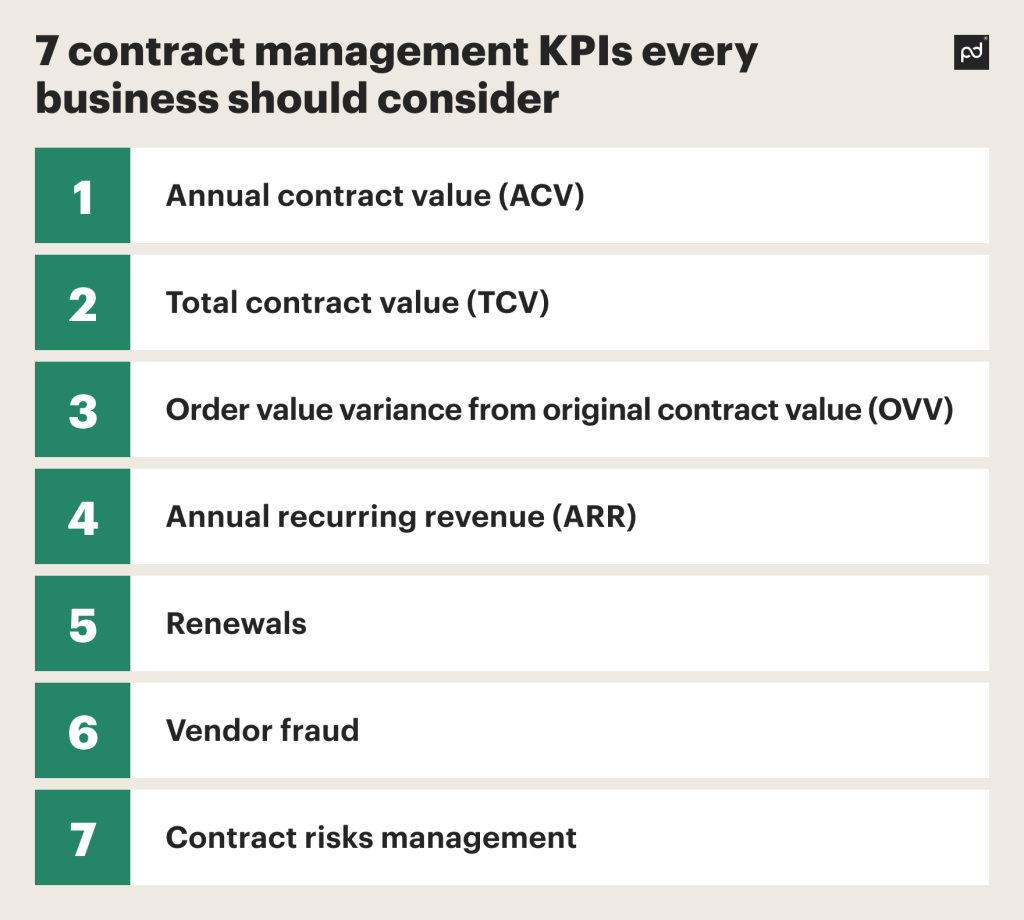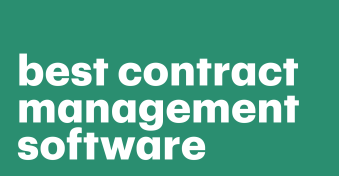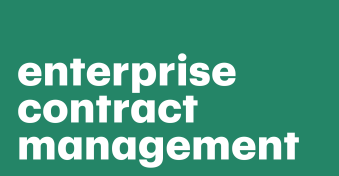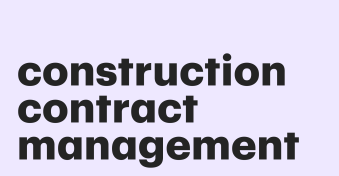Contract performance management is a strategic oversight of contracts, covering planning, execution, and optimization activities throughout the entire lifecycle.
The primary goal is to maximize the value derived from contractual relationships while minimizing risks and ensuring compliance with agreed-upon terms.
So which KPIs ensure your contracts hit the right targets?
Read on to see how harnessing key performance metrics enhance outcomes and discover the ways contract management software optimizes workflow and drives contract performance.
Key takeaways
- Contract performance metrics like total contract value (TCV), order value variance (OVV), annual recurring revenue (ARR), and renewals offer actionable insights into financial planning and resource allocation.
- These in-depth insights enable organizations to refine contract terms, monitor performance, and implement strategic contract management.
- Real-time monitoring of contract activities, milestones, and financial aspects ensures that deviations from the agreed-upon terms are identified promptly, saving budget and time.
How to improve contract performance
Let’s begin by focusing on actionable steps that can help optimize contract performance when your team is paired with the right software.
Unified content storage
A user-friendly interface allows you to organize all your contracts in one centralized repository. Easily tag contracts with details such as contract owner, type, duration, value, and renewal deadlines.
Automated contract creation
Drag-and-drop features help you easily create new documents, ensuring efficient and accurate contract generation.
Precise reminders
A robust system of contract reminders allows you to set alerts for contract renewal dates, ensuring proactive contract management and preventing missed renewal deadlines.
Real-time contract review
Adopt multi-faceted contract management tools to facilitate a seamless review and refinement process for contracts.
Collaborate in real-time, make edits, and gather feedback efficiently within the platform — doing so only helps establish the right contract workflow, always a good thing.
This enhances your team’s ability to adapt contracts to evolving business needs and industry standards.
Identification of strengths
Identify what works well and target areas for improvement to enhance your team’s preparedness for negotiations.
Implementing advanced automated workflows with conditional approvals will help you accelerate the approval process and reduce the risk of delays.
Legal compliance
PandaDoc ensures rigorous contract compliance by aligning closely with both external regulations and internal business policies.
Our platform incorporates legal standards and ethical practices, providing a secure environment for contract management.
ESIGN-compliant eSignatures facilitate the finalization of contracts, expediting the signing process and ensuring legal validity.
7 contract management KPIs every business should consider
Let’s now explore a few key contract performance metrics to gauge the ROI of your company’s contract management process.

Annual contract value (ACV)
Annual contract value (ACV) represents the yearly financial impact of a contract.
To calculate ACV, you divide the total contract value by the number of years covered by the contract.
For instance, for a two-year contract valued at $5,000,000, the calculation would be $5,000,000 / 2 = $2,500,000 per year.
ACV aids in financial forecasting, strategic planning, and decision-making.
It enables organizations to gauge the annual revenue impact of a contract, facilitating better resource allocation and budget planning.
Total contract value (TCV)
Total Contract Value (TCV) provides the total worth of a contract from initiation to completion.
To calculate TCV, you need to multiply the monthly recurring revenue (MRR) by the contract term length and add any applicable fees.
For example, a client signs a two-year contract with a software service provider featuring an MRR of $2,000 and a $250 onboarding fee.
The TCV for this contract is calculated as follows: ($2,000 x 24 months) + $250 = $48,250.
TCV provides businesses with a comprehensive view of the annual value of a contract per customer, considering recurring revenue and any additional fees.
And it provides the necessary data to put a spotlight on any contract value leakage that may occur, helping mitigate the loss of any further potential contract value.
Order value variance from original contract value (OVV)
The OVV metric measures the differences between the contracted values and the actual values of orders placed during the contract period.
Put simply, it helps evaluate whether the executed orders match the expectations outlined in the original contract.
For example, say there’s a manufacturing contract with an expected order value of $1 million annually.
However, the actual order total became $800,000 due to unforeseen circumstances, with OVV revealing a 20% difference.
This prompts the business to assess the reasons behind the discrepancy, possibly leading to strategic adjustments in future contract negotiations.
By understanding the patterns of order value fluctuations, you can adjust pricing models, identify areas of improvement, and enhance overall contract performance.
Annual recurring revenue (ARR)
Annual recurring revenue (ARR) is especially valuable for businesses with subscription models, providing a clear understanding of the predictable and recurring revenue generated from subscription-based services or products over a specific period, usually a year.
The formula for ARR is fairly simple:
ARR = (Total revenue from new subscriptions in a period) + (Recurring revenue from existing subscriptions at the beginning of the period) + (Upgrades or downgrades to existing subscriptions during the period) – (Churned revenue from existing subscriptions during the period).
Another way to calculate ARR is to multiply your monthly recurring revenue by 12.
For example, a SaaS company has a new subscription revenue of $15,000, recurring revenue from existing subscriptions at the beginning of the period amounting to $100,000, and upgrades or downgrades totaling $5,000.
If the churned revenue from existing subscriptions during the period is $8,000, the calculated ARR is $15,000+$100,000+$5,000−$8,000=$112,000.
Why does ARR matter? Tracking ARR allows businesses to strategically plan for revenue growth, identify expansion opportunities (upsells, cross-sells, etc.), and address challenges posed by customer churn.
Renewals
When it comes to contract performance management, there are a few types of renewal metrics you need to consider:
- Number of auto-renewals
- The overall percentage of contracts renewed
- Value of contracts renewed or nonrenewed
You need to know how and by whom a contract was renewed or terminated.
Contract renewal automation software provides detailed reports and can help you know exactly when it’s time to revisit the original contract and initiate the renewal process.
You’ll also want to analyze failed renewals to gain insights into overall business performance and the health of client relationships.
When a contract doesn’t get renewed, it’s a signal to dig a bit deeper.
What went wrong? Was it a service hiccup, a communication gap, or did you miss the mark on value? These insights are gold, guiding you toward areas that need a bit of polish.
Best practices for contract renewal and this contract renewal template are here to help you fine-tune your offerings and lower the cost of customer acquisition by retaining more clients.
Vendor fraud
Vendor fraud refers to deceptive practices by suppliers or service providers in a contractual relationship, seeking financial gain through unscrupulous means or attempting to dishonestly bow out of an enforceable contract after receiving payment for (but not delivering) products or services.
Typical indicators and patterns of vendor fraud can vary across industries, making it crucial for organizations to take precautionary measures.
These may include:
- Implementing due diligence before entering into contracts can uncover potential red flags related to a vendor’s financial stability, reputation, and past dealings.
- Analyzing financial transactions can help identify irregularities and anomalies that may indicate fraudulent activities.
- Conducting audits of vendor contracts will verify the accuracy of invoiced amounts and the legitimacy of services rendered.
Contract risks management
Contract risks involve considerations both before and after the point of signing.
While the pre-signature phase prioritizes comprehensive risk mitigation during commercial negotiations and legal review, ongoing risk assessment must persist throughout the contract’s start-up, operation, renewal, and close-out stages.
- Develop detailed risk mitigation plans tailored to each identified risk category.
- Integrate clauses designed to act as safeguards against potential risks.
- These may include penalty mechanisms, contingency plans, and clearly defined responsibilities.
- Implement ongoing monitoring to track changes, ensuring regular reassessment and strategy updates.
How can a contract lifecycle management platform help?
To supercharge contract performance, consider integrating a platform designed for contract lifecycle management (CLM).
Doing so will help you:
- Utilize AI-powered data extraction for swift filtering and retrieval of critical contract information.
- Gain insights into contract performance through analytics.
- Set alerts to stay on top of contract renewal dates.
- Build trust by allowing every party to see all the essential things in one place.
- Stay updated about project deliverables, compliance policies, and regulatory issues.
Incorporate PandaDoc software to improve contract management performance
The right contract management tools combined with eSignature software will continuously improve your business’s contract management workflow.
And that’s where PandaDoc steps in and has you covered.
Experience a seamless journey from personalized onboarding and ongoing support for all your contract management needs.
Streamline your contract management with a trusted partner committed to your success, both before and after the purchase.
Schedule a demo or start your free 14-day trial today!
Disclaimer
PandaDoc is not a law firm, or a substitute for an attorney or law firm. This page is not intended to and does not provide legal advice. Should you have legal questions on the validity of e-signatures or digital signatures and the enforceability thereof, please consult with an attorney or law firm. Use of PandaDoc services are governed by our Terms of Use and Privacy Policy.


